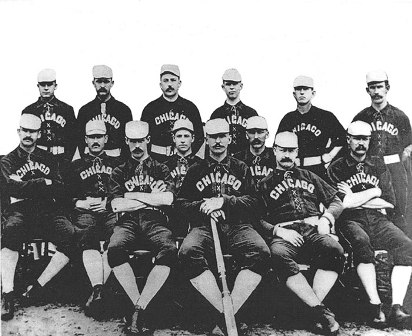Before the 1895 season, Henry Chadwick proposed “eight changes” to baseball in The New York Clipper:
“First: The doing away with ‘hoodlumism,’ as shown in the form of dirty ball playing and blackguard bickering.
“Second: Abolishing the bullying coaching business.
“Third: Prohibiting the wearing of the large mittens by any player on the field except the catcher.
“Fourth: A rewording of the balk rule so as to prohibit the feint to throw to the bases. At present the rule, in this respect is a dead letter.”
His frustration with balks not being called, was a regular subject for Chadwick That same season, he wrote in a different column:
“It will be seen, too, that, whenever the pitcher ‘feigns’ to throw the ball to first base he must do it while standing with ‘both feet on the ground.’ If he raises one foot in making the feint he commits a balk. Has anyone seen a balk called by any umpire when the pitcher has openly violated the rule by raising his foot and taking a sidestep to throw to a base?…The balk rule is more plainly written that many other rules in the game, and yet umpires make it a dead-letter law.”
Chadwick continued
“Fifth: The overrunning of all the bases, as recommended by George Wright at the convention of 1869.”
The “Spalding Guide,” edited by Chadwick, said that Wright had only proposed the rule that was adopted—overrunning first base–but that, “When the amendment was presented at the convention of 1869, (another) delegate wanted the rule applied to all bases, but the majority preferred to test the experiment as proposed at first base.”
The Guide did, however, during Chadwick’s tenure as editor, advocate for the overrunning of all bases:
“The most irritating disputes caused by questions involved in sliding to bases and in running up against base players are also due to the same cause. Why not put a stop to these injuries and these disputes by giving the base runner the same privileges in overrunning second (and) third…that he now has in overrunning first base? In every way will the adoption of the rule suggested be an improvement, and not the least of its advantages will be its gain to base running, which is, next to fielding, the most attractive feature of our game.”
His final three:
“Sixth: I would neither increase nor decrease the distance between the pitcher’s box and the home plate.
“Seventh: In regard to the ‘trap ball’ rule, I would make it applicable in every case wherein a batting base runner reaches first base unless by a clean base hit; but even then, only when the ‘force’ hit ball touches the hand of an infielder, not an outfielder. I think if a runner reaches first base by a clean base hit, it is not just that he shall be punished by an out incurred through the weak hitting of his successor at the bat, as he is under the rule of purposely dropping an infield fly ball.”
“Eighth: I think these catches on flytip balls sharp off the bat and fouled to the catcher and caught on the fly should be outs. Every such ball is generally over the plate and within due range.”
The “father of Baseball” had at least one supporter for his plan for “flytip balls,” to be outs regardless of the number of strikes on the batter. O.P. Caylor said in The New York Herald:
“Henry Chadwick thinks—and there is nothing wonderful about that, for he thinks correctly—that foil tips caught by the catcher right off the bat should be out.”



Leave a comment